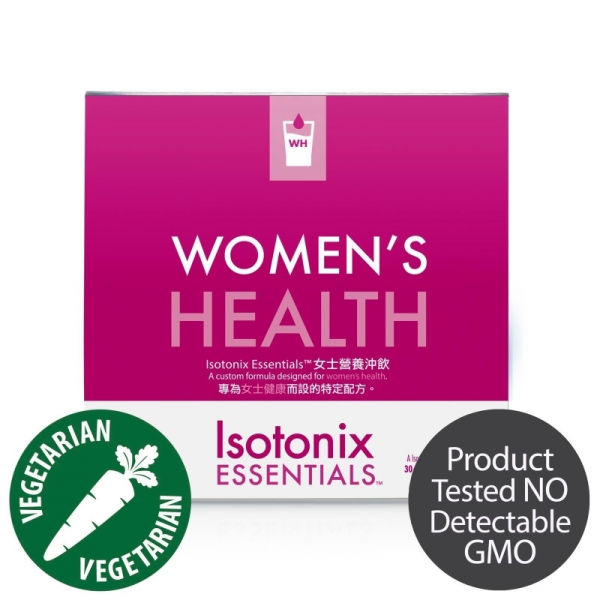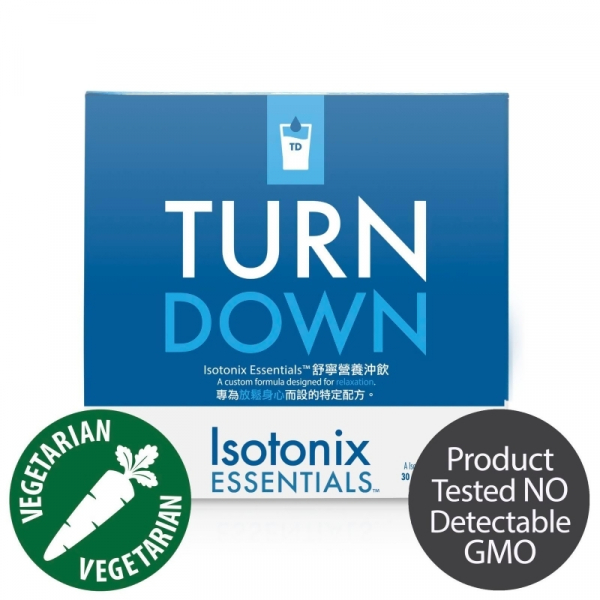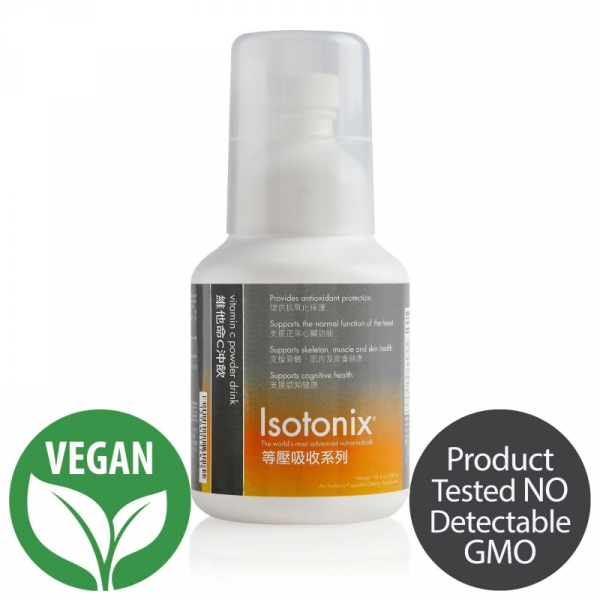Isotonix®孕婦活性綜合維他命沖飲
$441.00
單瓶裝 (45次份量)
Isotonix 孕婦活性綜合維他命沖飲是由等滲透溶液傳輸的營養補充物,包含具有代謝活性的葉酸以及其他維他命 B 群,並按照孕婦所需的每日建議攝取量提供關鍵的維他命和營養素。孕婦攝取的綜合維他命具有活性維他命及礦物質是十分重要。因為身體能輕易地吸收並運用當中的營養,不用額外去活化營養素。 Isotonix 孕婦活性綜合維他命沖飲使用卓越的等滲透傳輸系統,為孕婦提供具有活性的必需維他命 B 群,讓孕婦獲得綜合維他命的好處,而避免吞嚥片劑的困難。
益處
- 有助促進懷孕期間的健康
- 含有十種維他命及七種礦物質
- 有助維持健康的皮膚與毛髮
- 含有精選的活性維他命B群,確保能被身體充分利用
- 孕婦攝取適量葉酸可有助減少胎兒腦部或脊髓缺陷的風險
- 眾所皆知,懷孕期間若缺乏微量營養素(鋅、鐵、葉酸和碘)的攝取,會導致新嬰兒體重過低

產品分類

不含麩質 – 本產品不含可檢測出之麩質*
不含可檢測出之基改成份(GMO) – 本產品不含可檢測出之基因改造生物成份
素食品 – 本產品為素食產品
等滲壓營養補充沖飲 – 易於飲用的營養補充品 / 健康食品,透過等滲壓狀態達致更佳的營養吸收
品質標準 – 良好生產規範(GMP)運作與標準化成份
已檢測:重金屬丶微生物污染物丶過敏原丶效力丶純度及特性
*美國食品藥品監督管理局(FDA)將含有少於20PPM麩質的製成產品列為不含麩質
詳細資料
Isotonix孕婦活性綜合維他命沖飲是由等滲透溶液傳輸的營養補充物,包含具有代謝活性的葉酸以及其他維他命B群,並按照孕婦所需的每日建議攝取量提供關鍵的維他命和營養素。孕婦攝取的綜合維他命具有活性維他命及礦物質是十分重要。因為身體能輕易地吸收並運用當中的營養,不用額外去活化營養素。Isotonix孕婦活性綜合維他命沖飲使用卓越的等滲透傳輸系統,為孕婦提供具有活性的必需維他命B群,讓孕婦獲得綜合維他命的好處,而避免吞嚥片劑的困難。Isotonix孕婦活性綜合維他命沖飲有助維持懷孕期間健康,並支援胎兒正常健康的生長發育。此外,它能促進嬰兒健康的出生體重。Isotonix孕婦活性綜合維他命沖飲為可口的青檸口味,好味道。

了解更多
Isotonix®輸送系統
Isotonix系列產品是最有效的輸送營養補充品之一。配方採用先進和經科學證實的成分,提供高效輸送及卓越的效果。
Isotonix為等滲壓的原因是因為產品與人體內的液體相同,含有幾乎相同的濃縮可溶物,如盬、糖及礦物質。在此濃度下,營養及分子便能有效地通過細胞壁,用作細胞代謝。Isotonix產品配方中的果糖、葡萄糖、檸檬酸、碳酸氫鉀及其他主要成分搭配均衡,以確保正確調配飲用時達到等滲狀態。
Isotonix產品以適當的比例與濃度傳送營養素,以達致最佳的吸收。Isotonix是市場上經科學證實最有效的營養傳輸系統之一。
成份
β-胡蘿蔔素4000 IU:
在準備懷孕前建議攝取充足的維他命A。如你正考慮懷孕,Isotonix孕婦綜合維他命沖飲會是你的最佳選擇。適量的維他命A有助促進胚胎與胎兒的正常成長與發育,進而促進嬰兒的健康。維他命A亦能支援影響胚胎期決定器官順序發育的基因。β-胡蘿蔔素是來自植物的營養素,人體內會轉化為維他命A。
(維他命B1)(3毫克)
維他命B1是水溶性維他命,能促進身體對碳水化合物、脂肪及蛋白質的運用。身體的每個細胞都需要運用維他命B1來支持三磷酸腺苷(ATP)的形成,三磷酸腺苷是身體運作所使用的能量。神經細胞需要維他命B1來正常工作。由於懷孕期間的能量需求和產量增加,因此這些維他命的每日參考值(RDAs)亦需要隨之增加。
(維他命B2)(3毫克)
維他命B2是水溶性維他命,幫助身體處理氨基酸和脂肪,活化維他命B6和葉酸,促進碳水化合物轉換成三磷酸腺苷(ATP),作為身體運作的能量。維他命B2促進能量生產,由於懷孕期間能量產生增加,因此這些維他命的每日參考值(RDAs)亦需要隨之增加。
菸鹼素 20毫克:
菸鹼酸促進正常的能量產生。維他命B3與維他命B1及維他命B2一起運作,促進碳水化合物釋放能量。由於懷孕期間的能量需求和產量增加,因此這些維他命的每日參考值(RDAs)亦需要隨之增加。
泛酸 10毫克:
泛酸亦被稱為維他命B5,是水溶性維他命,參與克雷氏循環(Krebs Cycle)的能量製造當中,並促進神經遞質乙酰膽鹼的正常生產。泛酸與維他命B1、維他命B2及維他命B3一起運作,促進三磷酸腺苷(ATP)的生成,亦即身體運作的能源。維他命B5亦有助製造及傳送脂肪,並從脂肪中釋放能量。
(維他命B6)(4毫克):
維他命B6是處理胺基酸的主要維他命,是所有蛋白質和一些賀爾蒙的結構單元。維他命B6支援多種氨基酸的製造和分解。
維他命B12 12微克:
維他命B12是水溶性維他命,有助支持正常神經細胞活性、脫氧核糖核酸(DNA)的複製和影響情緒物質SAMe(S-腺苷-L-甲硫氨酸)的產生。在懷孕期間,攝取維他命B12能促進寶寶身體健康。
葉酸((6S)-5-甲基四氫葉酸、葡萄糖胺鹽、Quatrefolic)810微克:
葉酸主要在蔬果中找到。深綠色葉菜、橙、橙汁、豆類、豌豆和啤酒酵母是提供葉酸的最佳來源。葉酸在提升B12補充品效益方面擔當關鍵的角色。這兩種維他命B協力合作,維護正常的紅血球細胞。葉酸有助胺基酸及蛋白質的正常使用,並促進製造脫氧核糖核酸DNA與核糖核酸RNA物質的合成,進而維護身體所有功能。科學研究發現當維他命B12與葉酸一起運作時,能使同半胱胺酸的含量保持正常。這能有助支持健康的心血管與神經系統。
Quatrefolic是(6S)-5-甲基四氫葉酸的葡萄糖胺鹽,亦即活性最強的葉酸鹽,在結構上類似還原的活性葉酸。因為這種形式自然存在於體內,所以更具有生物可利用性,不需要在體內經過代謝。這項專利成分同時具有更高的穩定性與水溶性,非常適合用於Isotonix。*
生物素(300微克)
生物素是水溶性維他命B,做為輔酵素促進蛋白質、脂肪及碳水化合物進行新陳代謝。懷孕的婦女對生物素的需求會提高,然而高達50%的孕婦沒有攝取到足夠的生物素。
維他命C(120毫克)
維他命C又稱為抗壞血酸,屬於水溶性維他命,具有多種生物功能,能促進組織正常修復及癒合。此外,維他命C亦能增強免疫系統。女性在懷孕時身體會需要更多的維他命C,以促進寶寶的正常發育、支援建造強壯的骨骼與牙齒。維他命C同時也能支援懷孕期其他所需關鍵營養素 — 鐵 — 的吸收。
維他命 D3(膽鈣化醇):1,000 IU:
懷孕的婦女需要更多的維他命D。維他命D的主要功能在於維持血清鈣的濃度正常。維他命D促進腸道更有效率地吸收鈣質,主要在十二指腸與空腸內,促進鈣結合蛋白的合成,吸收並留住鈣質維持正常。
維他命E(D-α-生育酚醋酸酯)30 IU:
維他命E為脂溶性維他命,經證實為強效的抗氧化物,能經由母體吸收後傳送到胎兒身體中。維他命E能維護骨骼、心臟及平滑肌的結構和功能。維他命E促進紅血球生成,並且增強心血管與免疫系統的功能。
鈣(乳酸)150毫克:
另一個對孕婦很重要的營養素是鈣。懷孕婦女對鈣質的需求量會大幅提高。在懷孕期間,健康的鈣質含量有助母體維持正常的血壓與水分平衡。在懷孕期間,母體會移轉大量的鈣質到胎兒身體內,以幫助寶寶骨骼和牙齒的發育。在最初的六個月內,孕婦會在自己的骨骼中儲存鈣質。當胎兒在懷孕期最後三個月達到骨骼發育的巔峰,會吸收在母體中儲存的鈣質。孕婦需要增加攝取含大量鈣質的食物,如牛奶及奶類製品,以免因鈣質不足造成對孕婦牙齒與骨骼的傷害。
銅(葡萄糖酸銅)(0.22毫克):
銅是必要的微量營養素,在飲食與身體中都非常重要。銅能促進正常的鐵質吸收與運用。銅也是抗氧化酵素—超氧化物歧化酶(SOD)的一部分。銅能促進體內用以維持功能的物質—腺苷三磷酸(ATP)的正常產生。銅支援嬰兒正常的發育、紅血球與白血球的成熟、鐵的運輸、骨骼強度、心肌收縮、葡萄糖代謝、腦部發育與免疫功能。
鐵質 20毫克:
鐵質是懷孕期間重要的礦物質,能有助媽媽及胎兒血液的攜氧能力。鐵質不足會導致寶寶產生缺陷。鐵質是血紅素的一部分,是血液中攜帶氧氣的必須礦物質。鐵質是血液形成的必要元素。在懷孕期間的需求量顯著增加,因為孕婦的血液量增加,而胎兒的紅血球細胞亦需要發展。為了支持胎兒組織的生長,血液量及其含量必須增長,以提供養分給這些組織,包括紅血球細胞。此外,母體內約三分之一的鐵質將被傳遞給嬰兒,以形成其血液並儲存供將來使用。
鎂(碳酸)100毫克:
鎂是必須的礦物質,支援正常的骨骼、蛋白質及脂肪酸生成,促進細胞生成,活化維他命B群的效能,放鬆肌肉,凝結血液及支援身體運作所需能量ATP(腺苷三磷酸)的生成。鎂能促進健康的骨骼(人體64%的鎂濃縮在骨骼中)。它支持正常的骨骼結構,並在300多個細胞反應中扮演關鍵的角色。鎂可幫助維持懷孕期間的肌肉舒適。
鋅(乳酸)7.5毫克:
鋅是一種必要的礦物質,構成300多種酵素的元素,來支援正常癒合、成年人生育、兒童生長、蛋白質合成,細胞繁殖、視力、免疫功能,以及抵禦自由基等。鋅支援懷孕期間正常的生長發育。
鉬(鉬酸鈉)50微克:
鉬是必要的微量礦物質,能支援特定仰賴酵素作用的身體功能,包括鐵質的代謝,對於懷孕婦女非常重要。
常見問答
甚麼是孕婦綜合維他命?
這是專為孕婦而設的綜合維他命配方,補充孕婦在懷孕期間營養攝取的不足。雖然營養補充品含有多種維他命及礦物質,但其中的葉酸、鐵和鈣質含量尤其重要。
為甚麼孕婦需要大量的葉酸,鐵和鈣質?
葉酸促進胎兒中樞神經系統的發展,含有適量葉酸的健康飲食可降低胎兒患有大腦或脊椎神經缺陷的風險。葉酸是維他命B群的一種,能促進正常的細胞複製與生長。葉酸的天然來源包括綠色葉類蔬菜、果仁、豆類及柑橘類水果,也可以在多種強化早餐穀物及維他命補充品中找到。鈣質有助孕婦在懷孕期間維持自己的骨質密度,因為胎兒會使用此礦物質來生長骨骼。鐵支援孕婦和嬰兒的血液攜氧能力。雖然每日補充維他命不能代替健康飲食,但大多數女性需要使用營養補充品才能確保獲得足夠的所需礦物質。
應該食用孕婦維他命多久?
孕婦可以在整段懷孕期間補充Isotonix孕婦活性綜合維他命沖飲。你亦可以在懷孕後繼續補充,因為當中含有豐富的維他命及礦物質。
Isotonix孕婦活性綜合維他命沖飲當中含有甚麼「活性」成分?
活性是指具活性形式的維他命B6、B12、和葉酸。如果是以非活性的形式,這些維他命會需要由酵素活性化後才能被身體運用。這不只會消耗較多時間和身體的能量,在有些情況中,這種反應會被減緩或是抑制。
為甚麼具活性的葉酸對孕婦特別重要?
葉酸是胎兒的腦幹和脊髓健康發育所需的必要元素的。當孕婦食用具活性的葉酸,能夠迅速攝取到其好處。
為甚麼在懷孕期間需要食用維他命及礦物質的營養補充品?
懷孕期間,攝取多種健康的食物很重要。然而有時會因為早上的不適、繁忙的行程和胎兒在發育期間營養需求的變化,可能難以攝取足夠的營養。不論懷孕期間是否有任何不規律的飲食習慣,孕婦維他命的特別配方能確保孕婦和寶寶能夠獲得適量的營養。在懷孕期間,孕婦對鐵、葉酸和鈣質的需求大大增加,孕婦維他命是必需的。
我食用孕婦維他命後感到噁心,應該怎麼辦?
一些孕婦維他命可能會導致孕婦覺得噁心想吐。如果食用孕婦維他命讓你感到不適,請諮詢醫護人員。
我是否應該只在懷孕最初的幾個月及產前補充Isotonix孕婦活性綜合維他命沖飲,還是在懷孕期間持續飲用?
建議在整個懷孕期間飲用Isotonix孕婦活性綜合維他命沖飲。在懷孕期的不同階段,皆需要維他命和礦物質,以支援各個方面的所需。例如,含有葉酸的多種維他命在懷孕前和懷孕期間是尤其重要。近期的研究指出,含有葉酸的多種維他命也有助於體液平衡。
Isotonix孕婦活性綜合維他命沖飲只含有300毫克的鈣質嗎? 我應該要攝取額外的鈣質嗎?
建議孕婦每天攝取1000毫克鈣,以保持骨骼和牙齒堅固,以及支援寶寶的骨骼發育。每天至少食用三份含鈣豐富的乳製品,有助支援健康的鈣質攝取量。
飲用Isotonix孕婦活性綜合維他命沖飲有甚麼注意事項?
孕婦或哺乳期婦女在使用本品或任何營養補充品前,應諮詢專業醫護人員。避免兒童誤取此產品。本品含有鐵,意外攝取過量含鐵的補充品可導致六歲以下兒童中毒致命。
此產品適合素食者嗎?
適合。Isotonix孕婦活性綜合維他命沖飲是素食產品。
該如何飲用Isotonix孕婦活性綜合維他命沖飲?
按照醫護人員建議或標籤上的指示,每天飲用Isotonix孕婦活性綜合維他命沖飲。建議每日使用量為6.6克,即是兩蓋的份量。
飲用Isotonix孕婦活性綜合維他命沖飲安全嗎?
Isotonix孕婦活性綜合維他命沖飲是安全且不含有害物質。本產品在美國製造,並經美國食品及藥物管理局檢測設備生產,符合生產規範。顧客對本產品的質量和安全可絕對有信心。
科學
- Ryan-Harshman M et al. Folic acid and prevention of neural tube defects. Canadian Family Physician. 54(1):36-8, 2008.
- Czeizel A et al. Dose-dependent effect of folic acid on the prevention of orofacial clefts. Pediatrics. 104(6):e66, 1999.
- Ren A et al. Comparison of blood folate levels among pregnant Chinese women in areas with high and low prevalence of neural tube defects. Public Health Nutrition. 10(8):762-8, 2007.
- Brent R et al. Further efforts to reduce the incidence of neural tube defects. Pediatrics. 119(1):225-6, 2007.
- Lindsey L et al. Understanding optimal nutrition among women of childbearing age in the United States and Puerto Rico : employing formative research to lay the foundation for national birth defects prevention campaigns. Journal of Health Communication. 12(8):733-57, 2007.
- Scholl T et al. Folic acid: influence on the outcome of pregnancy. American Journal of Clinical Nutrition. 71(5 Supplement):1295S-1303S, 2000.
- Wald N et al. Quantifying the effect of folic acid. Lancet. 358(9298):2069-2073, 2001.
- Locksmith G et al. Preventing neural tube defects: the importance periconceptional folic acid supplements. Obstetrics and Gynecology. 321(7):1027-1034, 1998.
- Suarez L et al. Maternal serum B(12) levels and risk for neural tube defects in a Texas-Mexico border population. Annals of Epidemiology. 13(2):81-88, 2003.
- Candito M et al. Nutritional and genetic determinants of vitamin B and homocysteine metabolisms in neural tube defects: a multicenter case-control study. American Journal of Medical Genetics. 146(9):1128-33, 2008.
- Boyles A et al. Folate and one-carbon metabolism gene polymorphisms and their associations with oral facial clefts. American Journal of Medical Genetics. 146(4):440-9, 2008.
- Centers for Disease Control and Prevention (CDC). Prevalence of neural tube defects and folic acid knowledge and consumption–Puerto Rico, 1996-2006. MMWR Morbidity and Mortality Weekly Report. 57(1):10-3, 2008.
- Wilson R et al. Pre-conceptional vitamin/folic acid supplementation 2007: the use of folic acid in combination with a multivitamin supplement for the prevention of neural tube defects and other congenital anomalies. Journal of Obstetrics Gynecology Canada . 29(12):1003-26, 2007.
- Gupta P et al. Multimicronutrient supplementation for undernourished pregnant women and the birth size of their offspring: a double-blind, randomized, placebo-controlled trial. Archives of Pediatric and Adolescent Medicine. 161(1):58-64, 2007.
- Scholl T et al. Vitamin E: maternal concentrations are associated with fetal growth. American Journal of Clinical Nutrition. 84(6):1442-8, 2006.
- Kaiser L et al. Position of the American Dietetic Association: nutrition and lifestyle for a healthy pregnancy outcome. Journal of the American Dietetic Association. 108(3):553-61, 2008.
- Scholl T. Maternal nutrition before and during pregnancy. Nestlé Nutrition Workshop Series Pediatrics Program. 61:79-89, 2008.
- Pathak P et al. Prevalence of multiple micronutrient deficiencies amongst pregnant women in a rural area of Haryana. Indian Journal of Pediatrics. 71(11):1007-14, 2004. Review.
- Castillo-Durán C et al. Zinc supplementation and growth of the fetus and low birth weight infant. Journal of Nutrition. 133(5 Suppl 1):1494S-7S, 2003. Review.
- Wynn A and Wynn M. Magnesium and other nutrient deficiencies as possible causes of hypertension and low birth weight. Nutrition and Health. 6(2):69-88, 1988. Review.
- Scholl T et al. Folic acid: influence on the outcome of pregnancy. American Journal of Clinical Nutrition. 71(5 Supplement):1295S-1303S, 2000.
- Grant W et al. Benefits and requirements of vitamin D for optimal health: a review. Alternative Medicine Review. 10(2):94-111, 2005.
- Zagré N et al. Prenatal multiple micronutrient supplementation has greater impact on birth weight than supplementation with iron and folic acid: a cluster-randomized, double-blind, controlled programmatic study in rural Niger . Food and Nutrition Bulletin. 28(3):317-27, 2007.
- Hernandez-Diaz S et al. Risk of gestational hypertension in relation to folic acid supplementation during pregnancy. American Journal of Epidemiology. 156(9):806-812, 2002.
- Wen S et al. Folic acid supplementation in early second trimester and the risk of preeclampsia. American Journal of Obstetrics and Gynecology. 198(1):45.e1-7, 2008.
- Bodnar L et al. Maternal vitamin D deficiency increases the risk of preeclampsia. Journal of Clinical Endocrinology and Metabolism. 92(9):3517-22, 2007.
- Scholl T. Maternal nutrition before and during pregnancy. Nestlé Nutrition Workshop Series Pediatrics Program. 61:79-89, 2008.
- Repke J. Calcium, magnesium, and zinc supplementation and perinatal outcome. Clinical Obstetrics and Gynecology. 34(2):262-7, 1991. Review.
- Wynn A and Wynn M. Magnesium and other nutrient deficiencies as possible causes of hypertension and low birthweight. Nutrition and Health. 6(2):69-88, 1988. Review.
- Altura B et al. Magnesium deficiency-induced spasms of umbilical vessels: relation to preeclampsia, hypertension, growth retardation. Science. 221(4608):376-8, 1983.
- Hofmeyr G et al. Calcium supplementation to prevent pre-eclampsia–a systematic review. South African Medical Journal. 93(3):224-228, 2003.
- Coetzee E et al. A randomized controlled trial of intravenous magnesium sulphate versus placebo in the management of women with severe pre-clampsia. British Journal of Obstetrics and Gynecology. 105(3):300, 1998.
- Hypponen E. Vitamin D for the prevention of preeclampsia? A hypothesis. Nutrition Reviews. 63(7):225-232, 2005.
- Chappell L et al. Vitamin C and E supplementation in women at risk of preeclampsia is associated with changes in indices of oxidative stress and placental function. American Journal of Obstetrics and Gynecology. 187(3):777-784, 2002.
- Chappell L et al. Effect of antioxidants on the occurrence of pre-eclampsia in women at increased risk: a randomized trial. Lancet. 354(9181):810-816, 1999.
- Vaidya A, et al. Effects of antenatal multiple micronutrient supplementation on children’s weight and size at 2 years of age in Nepal : follow-up of a double-blind randomized controlled trial. Lancet. 371(9611):492-9, 2008.
- Wilcox A et al. Folic acid supplements and risk of facial clefts: national population based case-control study. British Medical Journal. 334(7591):464, 2007.
- Shaw G et al. Risks of orofacial clefts in children born to women using multivitamins containing folic acid periconceptionally. Lancet. 346(8972):393-6, 1995.
- Goh Y et al. Prenatal multivitamin supplementation and rates of congenital anomalies: a meta-analysis. Journal of Obstetrics and Gynecology Canada . 28(8):680-9, 2006. Review.
- Lindsey L et al. Understanding optimal nutrition among women of childbearing age in the United States and Puerto Rico : employing formative research to lay the foundation for national birth defects prevention campaigns. Journal of Health Communication. 12(8):733-57, 2007.
- Goh Y et al. Prenatal supplementation with multivitamins and the incidence of pediatric cancers: clinical and methodological considerations. Pediatrics Blood and Cancer. 50(2 Suppl):487-9; discussion 498, 2008. Review.
- Scholl T. Maternal nutrition before and during pregnancy. Nestle Nutrition Workshop Series Pediatric Program. 61:79-89, 2008.
- Czeizel A et al. Dose-dependent effect of folic acid on the prevention of orofacial clefts. Pediatrics. 104(6):e66, 1999.
- Scholl T et al. Folic acid: influence on the outcome of pregnancy. American Journal of Clinical Nutrition. 71(5 Supplement):1295S-1303S, 2000.
- Czeizel A et al. Maternal use of nutritional supplements during the first month of pregnancy and decreased risk of Down’s syndrome: case-control study. Nutrition. 21(6):698-704, 2005.
- Tho
- Merialdi M et al. Adding zinc to prenatal iron and folate tablets improves fetal neurobehavioral development. American Journal of Obstetrics and Gynecology. 180(2 Partt 1):483-490, 1999.
- Merialdi M et al. Randomized controlled trial of prenatal zinc supplementation and fetal bone growth. American Journal of Clinical Nutrition. 79(5):826-830, 2004.
- Boyles A et al. Folate and one-carbon metabolism gene polymorphisms and their associations with oral facial clefts. American Journal of Medical Genetics. 146(4):440-9, 2008.
- Morin P et al. Multivitamin supplement for primary prevention of birth defects: application of a preventive clinical practice. Canadian Family Physician. 53(12):2142-3, 2007.
- Mock D et al. Marginal biotin deficiency during normal pregnancy. American Journal of Clinical Nutrition. 75(2):295-299, 2002. • Scholl T et al. Folic acid: influence on the outcome of pregnancy. American Journal of Clinical Nutrition. 71(5 Supplement):1295S-1303S, 2000.
- Klenner F et al. Observations on the dose and administration of ascorbic acid when employed beyond the range of a vitamin in human pathology. Journal of Applied Nutrition. 23(3-4), 1971.
- Grant W et al. Benefits and requirements of vitamin D for optimal health: a review. Alternative Medicine Review. 10(2):94-111, 2005.
- Hollis B. Vitamin D requirement during pregnancy and lactation. Journal of Bone and Mineral Research. 22 Suppl 2:V39-44, 2007. Review.
- Kaiser L et al. Position of the American Dietetic Association: nutrition and lifestyle for a healthy pregnancy outcome. Journal of the American Dietetic Association. 108(3):553-61, 2008.












